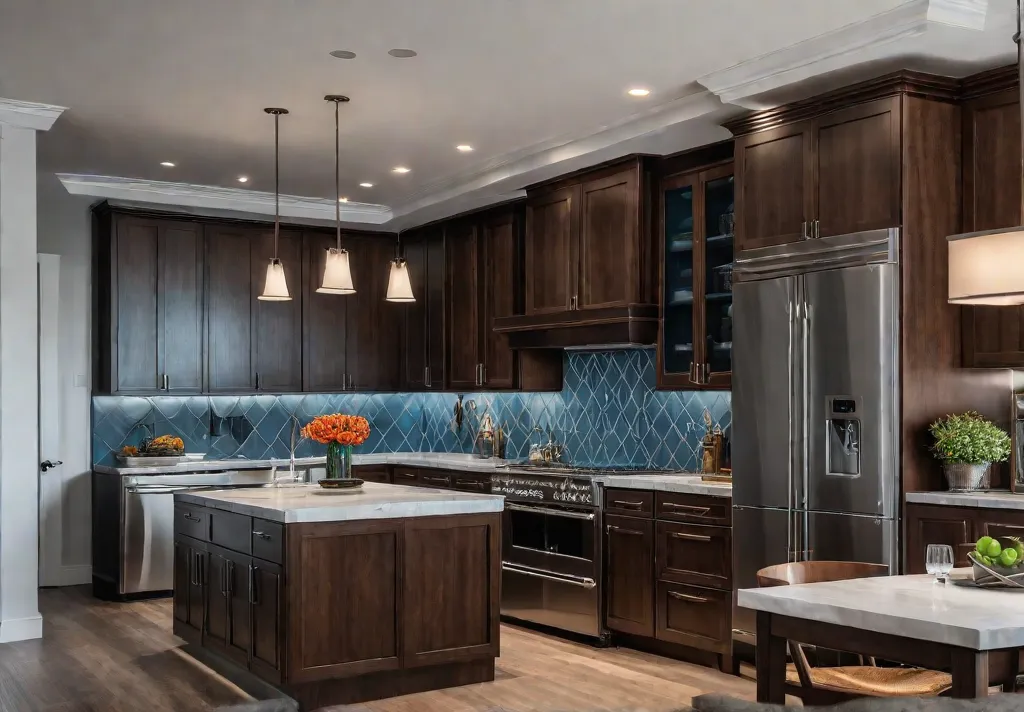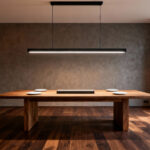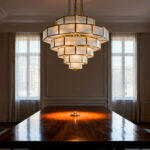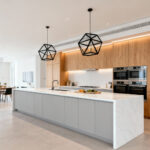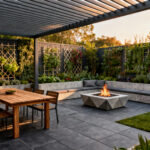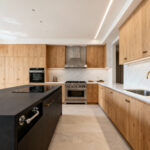Have you ever stepped into a kitchen that seamlessly blended the warmth of classic cabinetry with the sleek lines of contemporary design? A space that effortlessly marries the timeless allure of tradition with the vibrant energy of modernity? If not, allow me to paint a picture that will ignite your imagination and inspire you to create a kitchen that is both a culinary haven and a visual masterpiece.
Imagine an inviting space where rich wooden cabinets exude a sense of history and craftsmanship; their intricate details and warm hues evoke nostalgia. Yet, these traditional elements are expertly juxtaposed with clean, minimalist lines and cutting-edge appliances, creating a harmonious fusion of old and new. Gleaming countertops reflect the soft glow of statement lighting fixtures, which cast a warm, ambient radiance, while bold pops of color add a touch of playful sophistication.
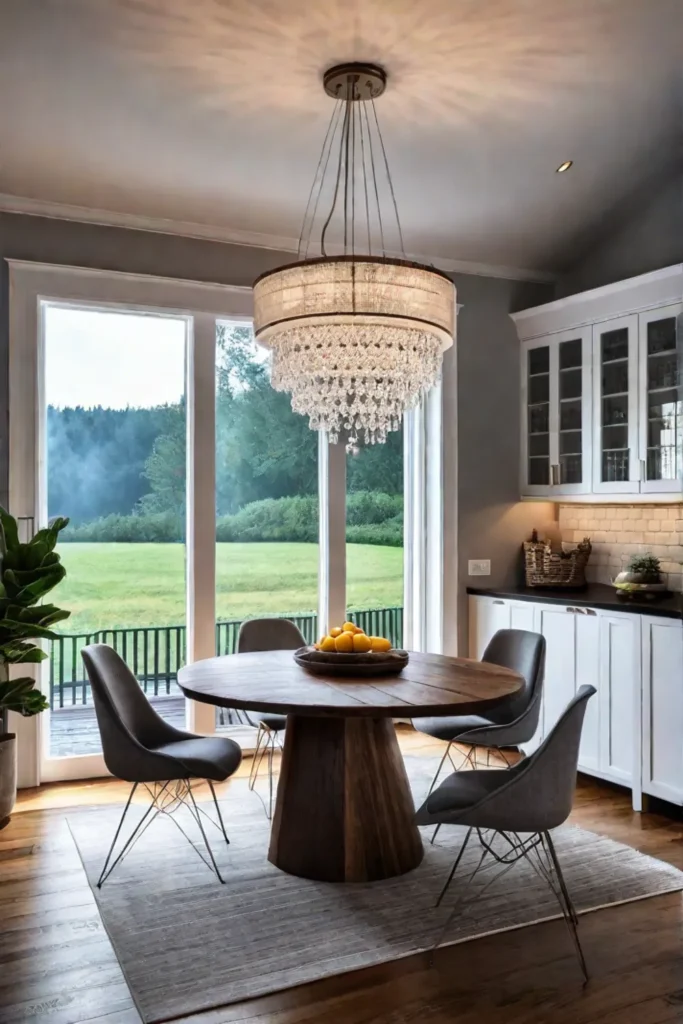
This, my friends, is the art of transitional kitchen design—a delicate balance of past and present, a symphony of contrasting elements that come together to create a space that is both visually stunning and highly functional. Today, I invite you to embark on a journey through the intricacies of this captivating style, exploring the secrets to achieving a kitchen that truly reflects your unique personality and lifestyle.
Mixing Materials: A Tapestry of Textures and Tones
One of the hallmarks of transitional kitchen design is the skillful incorporation of mixed materials, creating a visually compelling tapestry of textures and tones. Imagine the warm embrace of natural wood cabinetry seamlessly blending with stainless steel appliances sleek, industrial allure. Or envision the juxtaposition of raw, exposed brick against marble countertops’ cool, polished elegance.
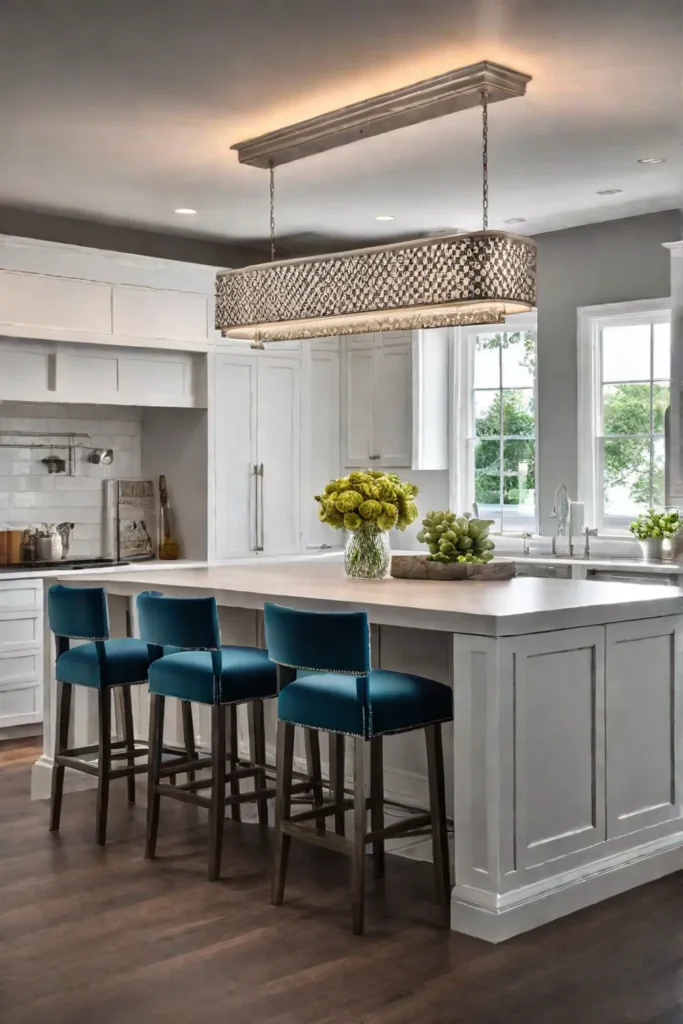
By strategically combining different materials, you add depth and visual interest to your kitchen and create a sense of timelessness that transcends fleeting trends. For instance, pairing warm wood cabinets with sleek stainless steel appliances can create a striking contrast that instantly elevates the space. Alternatively, incorporating glass-fronted cabinets allows you to display decorative items, adding a touch of personality while maintaining a cohesive aesthetic.
Moreover, the strategic use of materials can help define different zones within the kitchen, creating a sense of organization and flow. A textured backsplash or a contrasting island countertop can be a visual anchor, separating the cooking area from the dining or entertaining space.
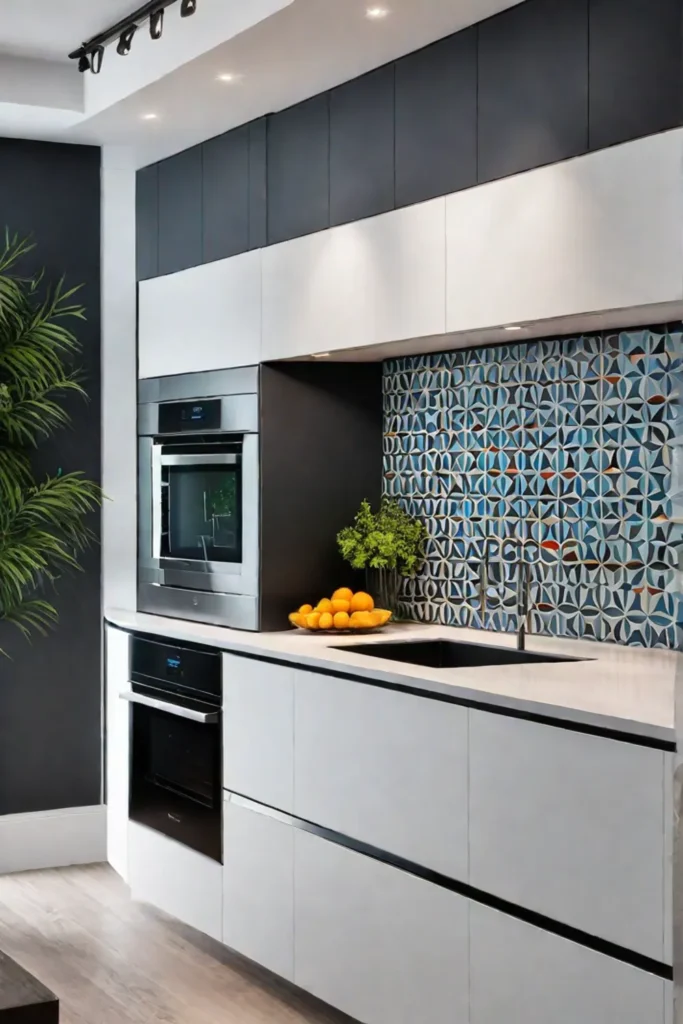
In the words of renowned architect Frank Lloyd Wright, “The reality of the building itself transcends all. Form follows function of necessity.” By embracing this philosophy and carefully curating a harmonious blend of materials, you can create a transitional kitchen that looks stunning and functions seamlessly, catering to your unique culinary needs and lifestyle.
Contrasting Colors: A Vibrant Interplay of Hues
As materials can create depth and texture, color is pivotal in crafting a visually striking and cohesive transitional kitchen. By skillfully balancing traditional and contemporary color palettes, you can achieve a space that is both timeless and utterly captivating.
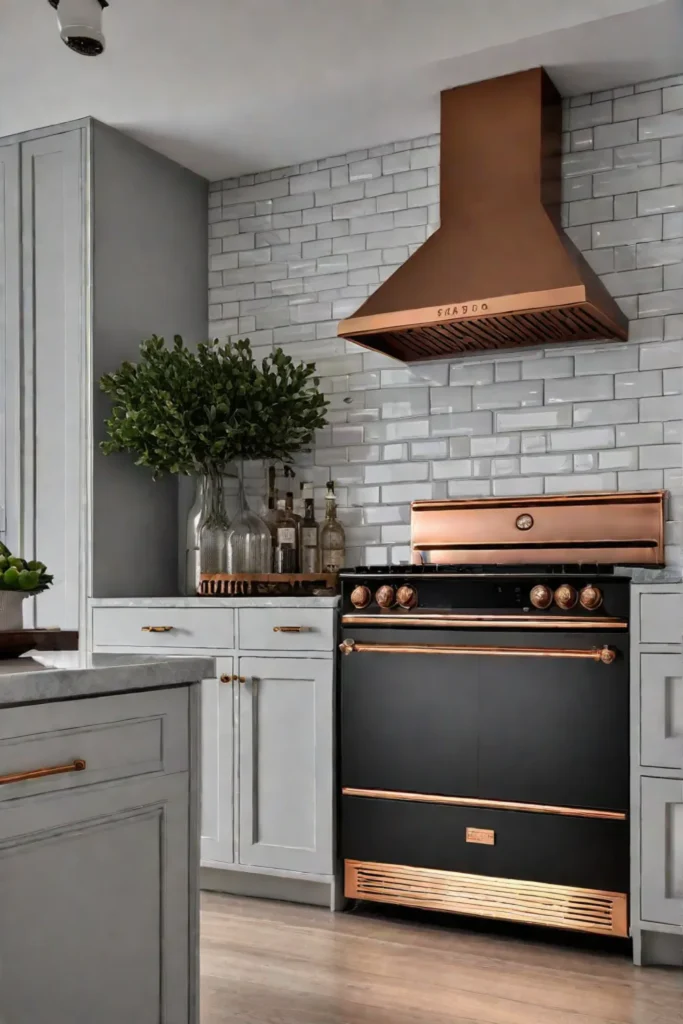
Imagine the classic elegance of white cabinets juxtaposed with a bold, contrasting backsplash or island color. This daring combination adds visual interest and creates a sense of drama and sophistication that is quintessentially modern. Alternatively, you could embrace the warmth of dark-colored cabinetry, complemented by lighter countertops and walls, creating a cozy and inviting atmosphere that harkens back to the charm of bygone eras.
Color can also define different zones within the kitchen, creating a sense of organization and flow. A deeper hue for the lower cabinets and a lighter shade for the upper cabinets can visually separate these areas. In contrast, strategically placed pops of color through accessories, artwork, or even a bold light fixture can add character and personality to the space.

As the legendary designer Charles Rennie Mackintosh once said, “There is as much craft in making a house beautiful as there is in making a beautiful book.” By embracing this philosophy and carefully curating a harmonious color palette, you can create a transitional kitchen that looks stunning and reflects your unique sense of style and personality.
Integrating Modern Appliances: Functionality Meets Sophistication
In the ever-evolving world of kitchen design, the seamless integration of modern, high-performance appliances is a must. However, achieving this harmonious fusion of functionality and sophistication in a transitional kitchen requires careful consideration and attention to detail.

When selecting appliances, it’s essential to choose pieces that complement the space’s overall aesthetic. Sleek, stainless steel appliances can blend seamlessly with classic wood cabinets, creating a modern and contemporary look that still pays homage to tradition. Alternatively, built-in appliances can create a more integrated and streamlined appearance, helping maintain a cohesive kitchen aesthetic.
But the art of integrating modern appliances goes beyond mere aesthetics. It’s also about finding the perfect balance between showcasing these high-tech marvels and seamlessly blending them into the overall design. For instance, you could showcase a bold statement hood as a focal point, adding visual interest and a touch of drama to the space. Conversely, concealing appliances behind cabinetry can create a more understated and cohesive look, allowing the timeless beauty of your traditional cabinetry to take center stage.

The legendary designer Mies van der Rohe once said, “Less is more.” By embracing this philosophy and carefully integrating modern appliances into your transitional kitchen design, you can create a space that looks stunning and functions seamlessly, catering to your culinary needs and lifestyle with the utmost efficiency and sophistication.
Statement Lighting: Illuminating the Perfect Blend
In transitional kitchen design, statement lighting is crucial in bridging the gap between traditional and contemporary elements. By carefully selecting and positioning lighting fixtures, you can create a visually stunning and harmonious space that seamlessly blends the old and the new.
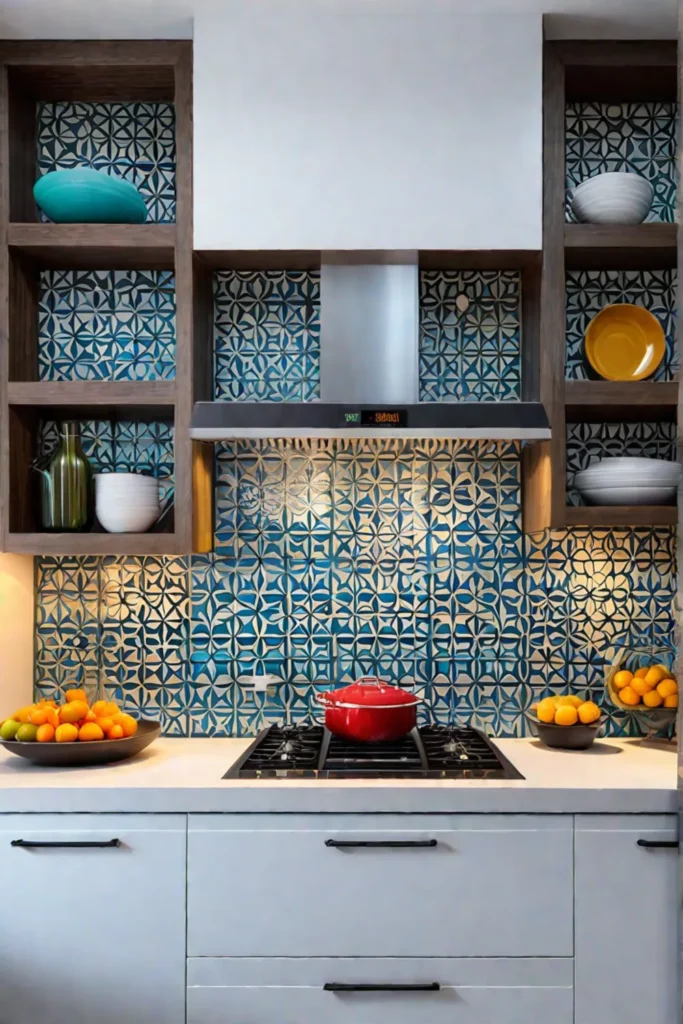
Imagine the warm, ambient glow of a classic, ornate chandelier casting a soft radiance over your traditional cabinetry while sleek, contemporary pendant lights add a touch of modernity and visual interest. This artful combination illuminates the space and creates a sense of depth and dimension, drawing the eye to the intricate details of your cabinetry while simultaneously showcasing the clean lines of your contemporary accents.
Lighting can also define different zones within the kitchen, creating a sense of organization and flow. A combination of overhead and under-cabinet lighting can help to create a well-lit and functional workspace, while strategically placed accent lighting can highlight key design elements or create a warm, inviting atmosphere for entertaining.
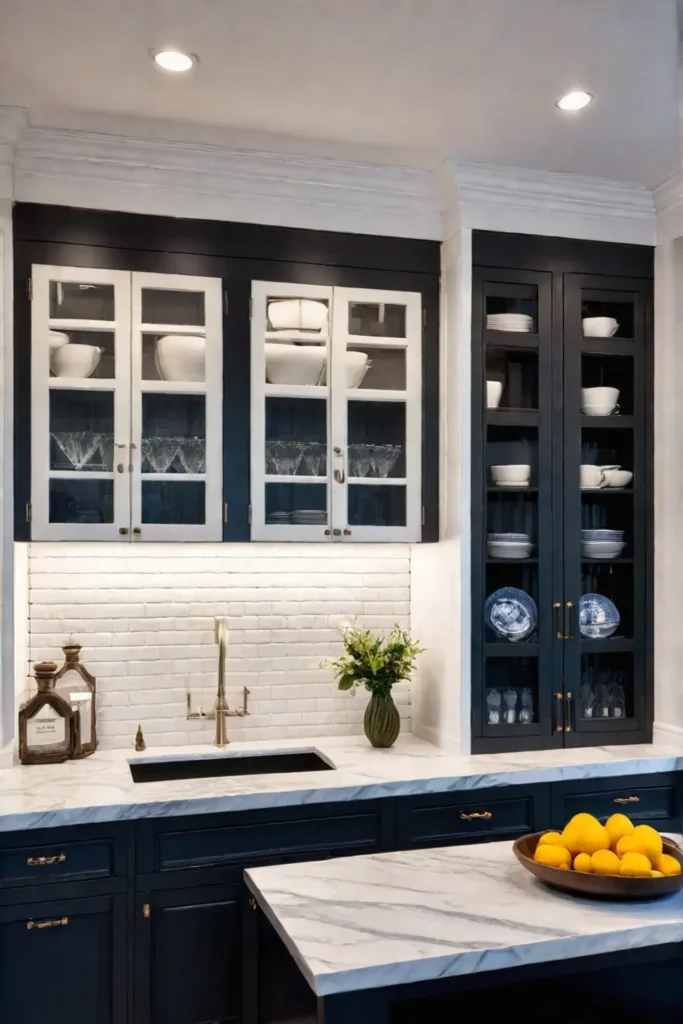
As the legendary designer Thomas Edison once said, “Genius is one percent inspiration and ninety-nine percent perspiration.” By embracing this philosophy and carefully curating the perfect blend of statement lighting, you can create a transitional kitchen that looks stunning and functions seamlessly, catering to your culinary needs and lifestyle with the utmost efficiency and sophistication.
Balancing Aesthetic and Function: A Harmonious Fusion
The delicate balance between aesthetic appeal and practical functionality is at the heart of any successful transitional kitchen design. After all, a kitchen is not merely a showpiece; it’s a hardworking space that must cater to your culinary needs and lifestyle with efficiency and ease.
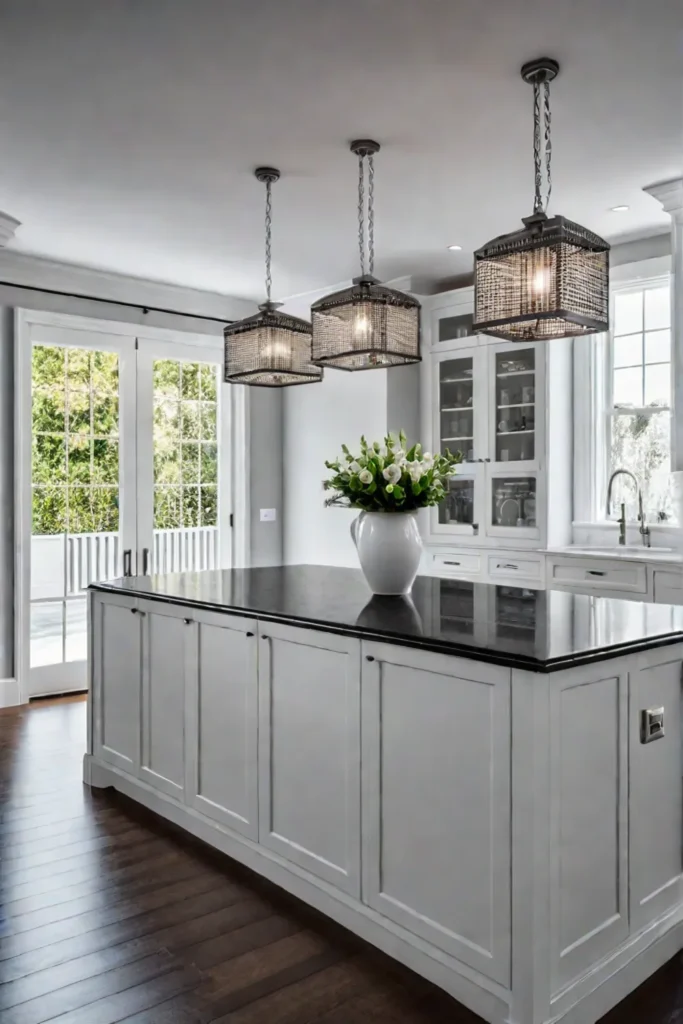
To achieve this harmonious fusion, it’s essential to prioritize functionality while maintaining a visually appealing design. This can involve incorporating modern storage solutions, such as pull-out drawers and built-in organizers, to keep a clean, uncluttered look. Alternatively, you could opt for a combination of open and closed cabinetry, creating a visually interesting and functional space for display and storage.
Another key consideration is ensuring a cohesive flow throughout the kitchen. This can be achieved using a consistent material, such as a natural stone countertop, throughout the space, creating a sense of unity and continuity. Alternatively, a complementary color palette can help to create a harmonious and visually pleasing environment, ensuring that all the elements work together seamlessly.
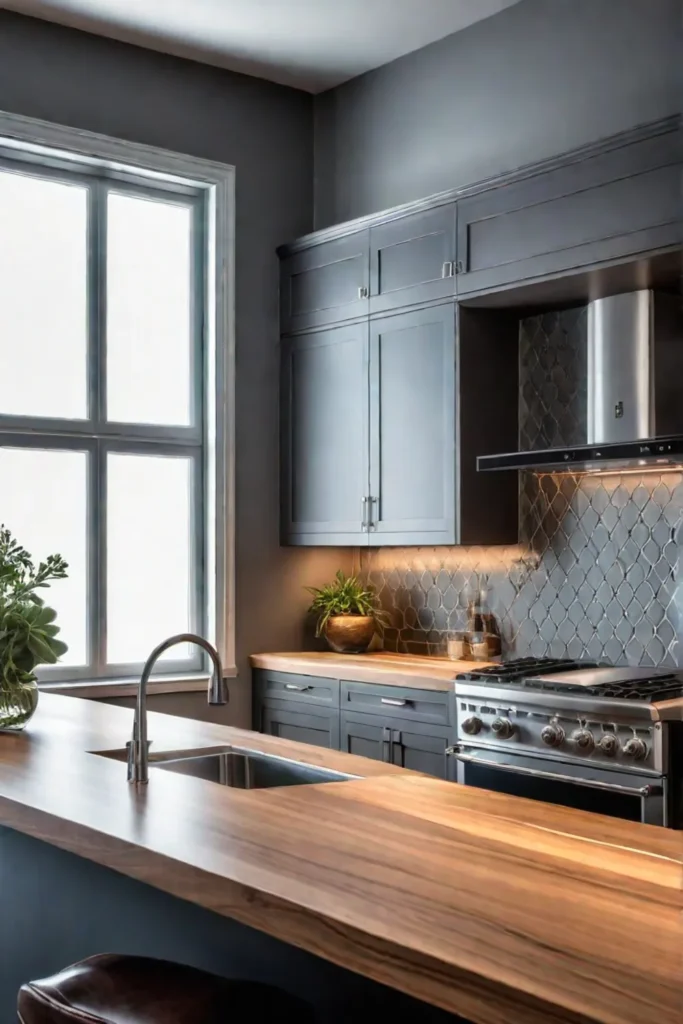
As the renowned architect Frank Gehry once said, “Architecture should speak of its time and place but yearn for timelessness.” By embracing this philosophy and carefully balancing aesthetic appeal with practical functionality, you can create a transitional kitchen that looks stunning and functions seamlessly, catering to your culinary needs and lifestyle with the utmost efficiency and sophistication.
Embracing the Unexpected: A Touch of Whimsy and Personality
While adhering to transitional design principles is essential, embracing the unexpected and infusing your kitchen with a touch of whimsy and personality is equally important. After all, a space reflecting your unique style and character will bring you joy and inspiration for years.
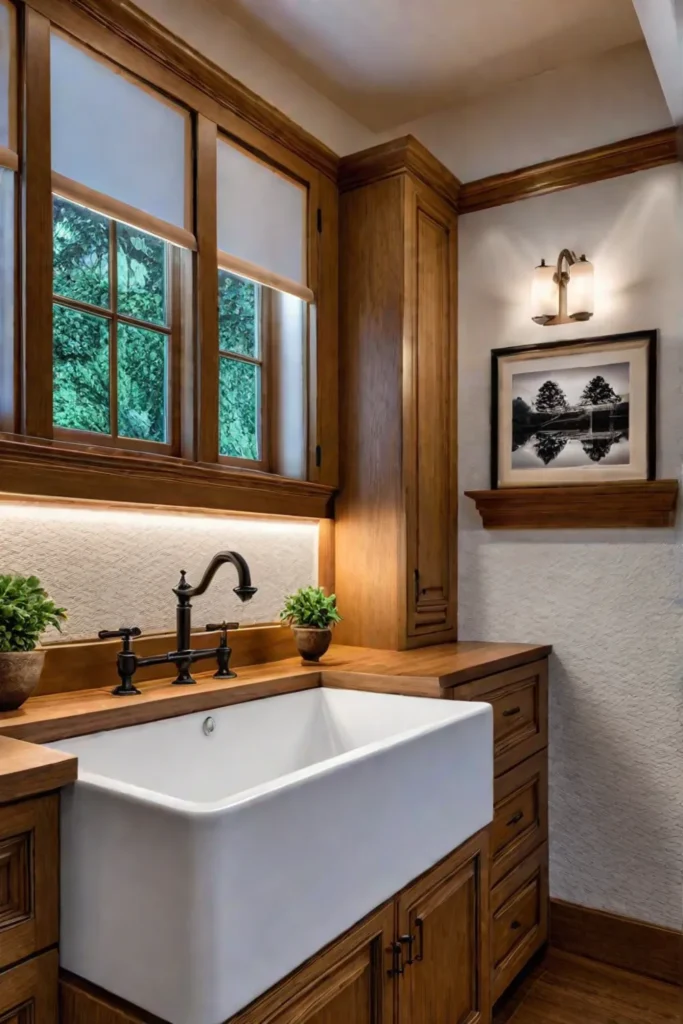
One way to achieve this is by incorporating unexpected materials, textures, or design features that create visual contrast and add depth to the space. For instance, you could include a vintage or antique piece of furniture in your contemporary kitchen, creating a sense of character and history that adds warmth and charm to the space. Alternatively, a bold, patterned tile as an accent feature can add visual interest and create a sense of contrast, breaking up the monotony of a more traditional design.
Incorporating personal touches and meaningful items is another way to infuse your transitional kitchen with personality. Family heirlooms, artwork, or a collection of cherished cookbooks can add character and a sense of individuality to the space, creating a warm and inviting atmosphere that truly reflects your unique style and sensibilities.
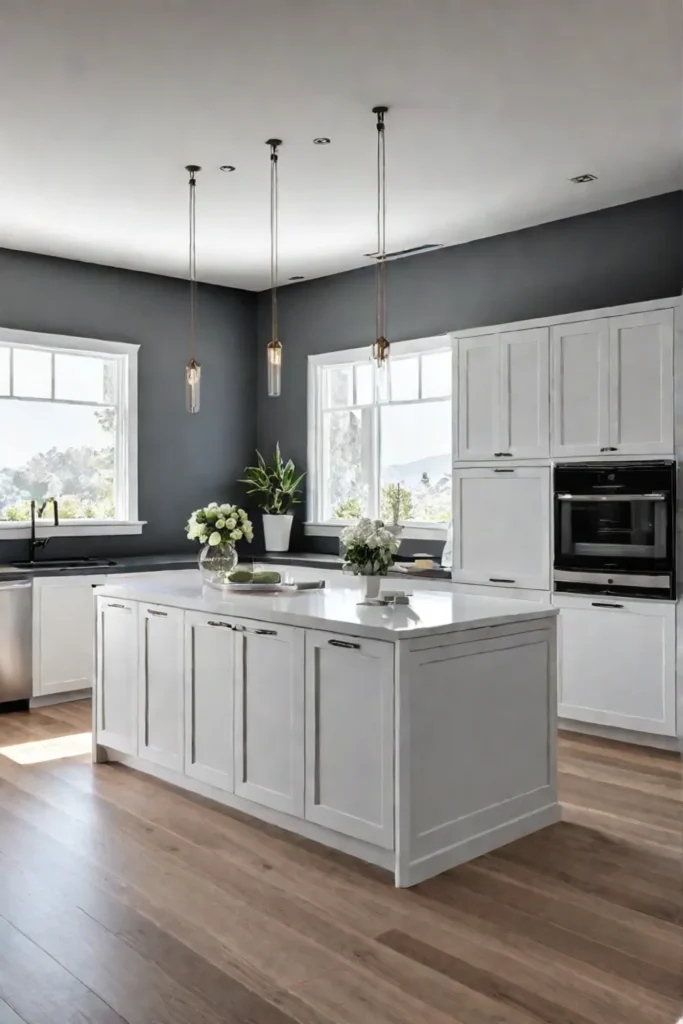
As the legendary designer Charles Eames once said, “The details are not the details. They make the design.” By embracing this philosophy and incorporating unexpected elements and personal touches into your transitional kitchen design, you can create a space that looks stunning and feels like a true reflection of your authentic self.
Celebrating Timeless Craftsmanship: A Nod to Tradition
While embracing contemporary design elements is essential in creating a transitional kitchen, it’s equally important to honor traditional cabinetry’s timeless craftsmanship and attention to detail. After all, these elements imbue your space with a sense of history and character, creating a warm and inviting atmosphere that transcends fleeting trends.
One way to celebrate this craftsmanship is by showcasing your traditional cabinetry’s natural beauty and quality. Highlight the intricate details and high-quality materials, allowing the warmth of the wood grain and the elaborate carvings to take center stage. Alternatively, you could incorporate custom or bespoke features, such as hand-crafted hardware or trim, adding a touch of elegance and personalization to the space.
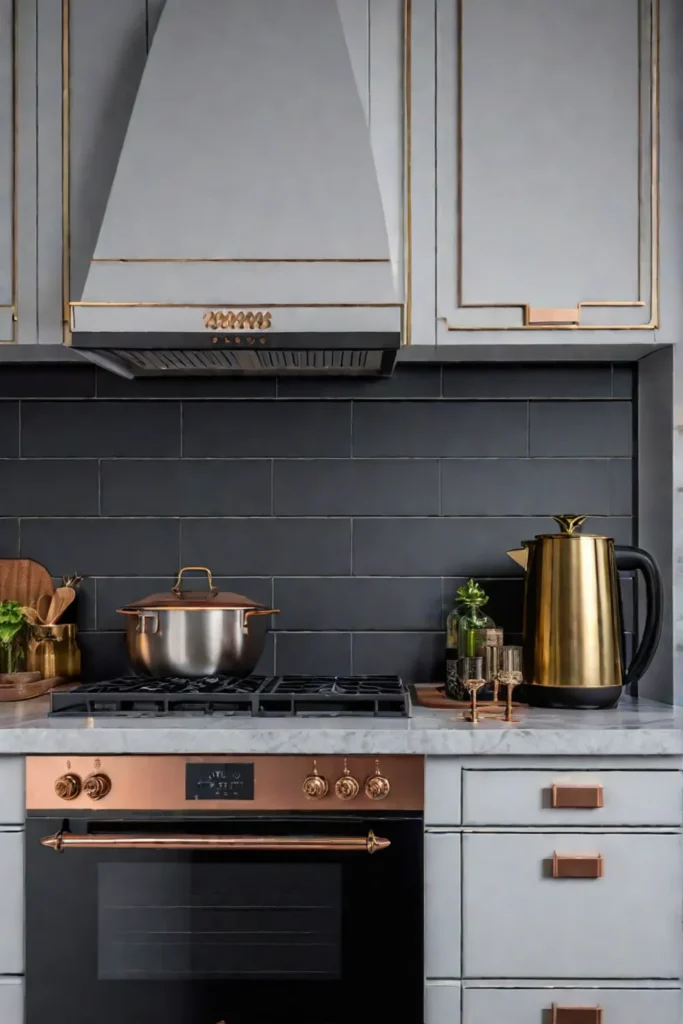
Another way to honor tradition is to use craftsmanship as a design feature. For instance, you could incorporate a wood grain or textured finish on your cabinets, creating a sense of depth and visual interest that pays homage to the artisanal techniques of bygone eras.
As the legendary designer Charles Rennie Mackintosh once said, “Art is the flower, craft is the stem without which it could not have blossomed.” By embracing this philosophy and celebrating the timeless craftsmanship inherent in traditional cabinetry, you can create a transitional kitchen that looks stunning and feels deeply meaningful and authentic, a true reflection of the rich tapestry of design history.
Achieving a Cohesive Aesthetic: The Harmonious Whole
While each element of your transitional kitchen design plays a crucial role in creating a visually stunning and functional space, the cohesive aesthetic truly brings the entire vision together. By ensuring a harmonious flow and consistent design theme throughout the kitchen, you can create a seamless, inviting, and utterly captivating space.

One way to achieve this cohesive aesthetic is by identifying a unifying design theme or color palette and incorporating it throughout the space. This could involve using a consistent material, such as a natural stone countertop, or embracing a complementary color scheme that ties the entire design together. Alternatively, you could use consistent materials and finishes throughout the kitchen, creating a sense of unity and continuity that transcends individual design elements.
Another key consideration is ensuring a smooth flow between different zones within the kitchen. This can be achieved using a consistent material, such as a natural stone countertop, throughout the space, creating a sense of unity and continuity. Alternatively, a complementary color palette can help to create a harmonious and visually pleasing environment, ensuring that all the elements work together seamlessly.
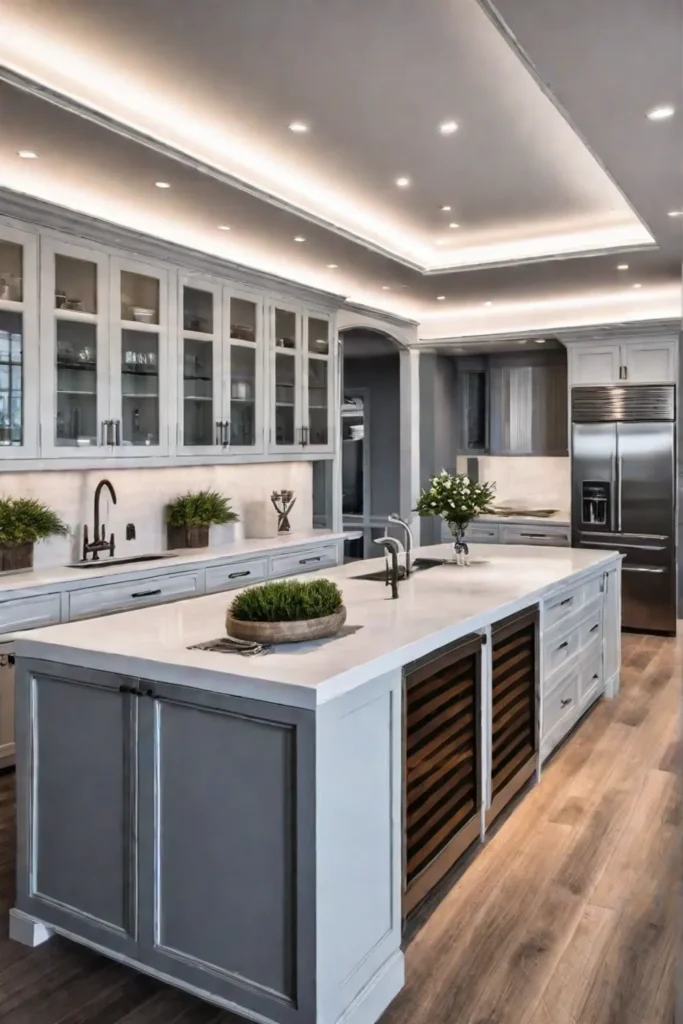
As the legendary designer Ludwig Mies van der Rohe once said, “God is in the details.” By embracing this philosophy and striving for a cohesive aesthetic throughout your transitional kitchen design, you can create a seamless, inviting, and utterly captivating space, a true reflection of your unique style and sensibilities.
A Timeless Masterpiece
In the ever-evolving world of kitchen design, blending traditional kitchen cabinets with contemporary design elements is a delicate balance that requires careful consideration and attention to detail. By skillfully incorporating mixed materials, contrasting colors, modern appliances, and statement lighting, you can create a transitional kitchen that is both visually stunning and highly functional.
But it’s not just about aesthetics; it’s about creating a space that reflects your unique personality and lifestyle. By embracing the unexpected, celebrating timeless craftsmanship, and striving for a cohesive aesthetic, you can achieve a kitchen that is a culinary haven and a living, breathing masterpiece. This space transcends fleeting trends and is a testament to your impeccable taste and discerning eye.
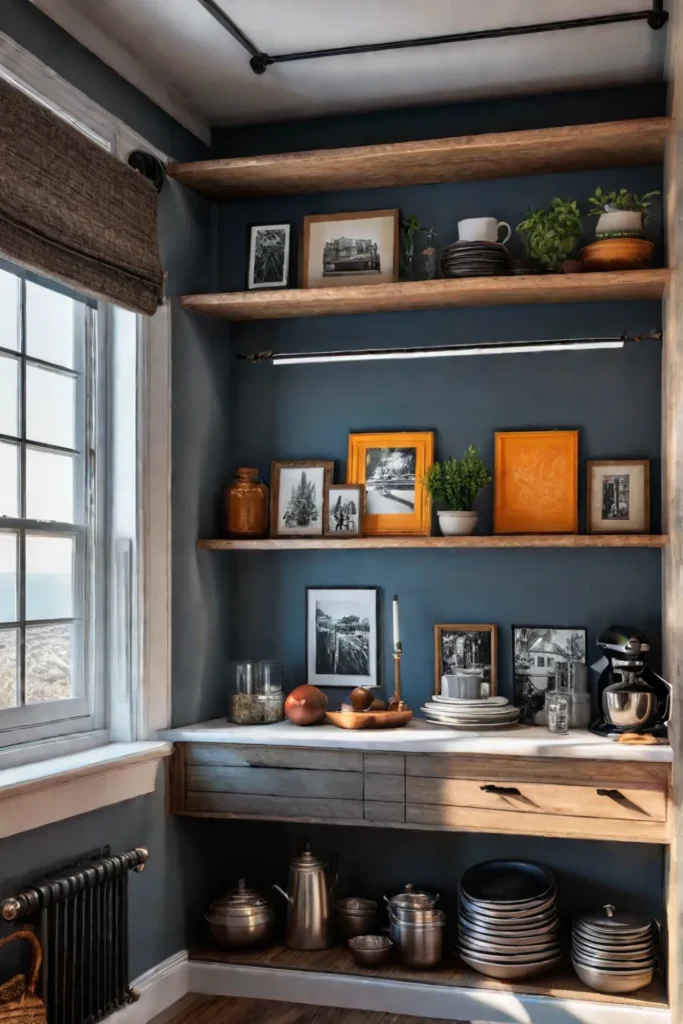
So, whether you’re embarking on a kitchen renovation or simply seeking to infuse your existing space with a touch of transitional flair, embrace the art of blending old and new, tradition and modernity. In doing so, you’ll create a space that truly resonates with your soul, a space that not only looks stunning but also feels like a warm embrace, welcoming you home with open arms and inspiring you to create, entertain, and savor every moment in the heart of your home.
